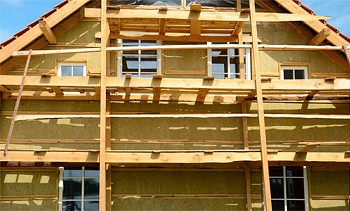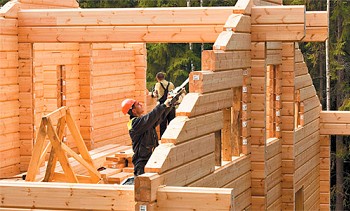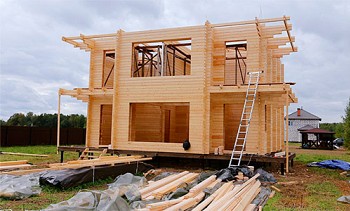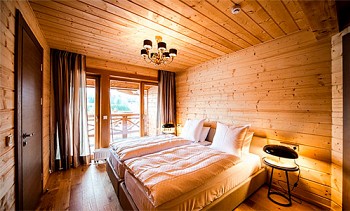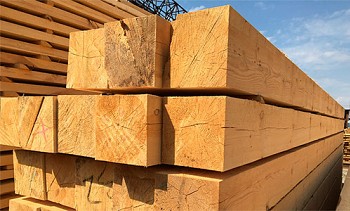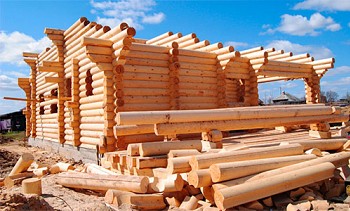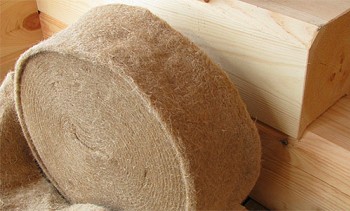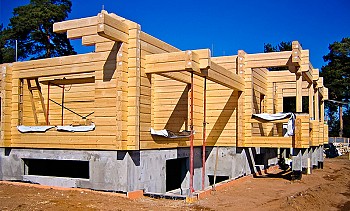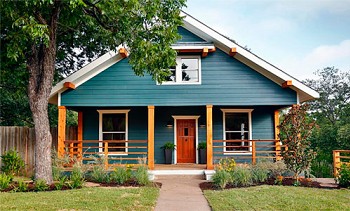Houses made of timber in recent years have become very popular. One of the main reasons for this popularity is a stylish look, a special architecture, rooted in the history of ancient Russian architecture. But before you decide to build this beauty, it is worth understanding the nuances of wooden house building, clearly imagine what qualities a timber house has, its pros and cons.
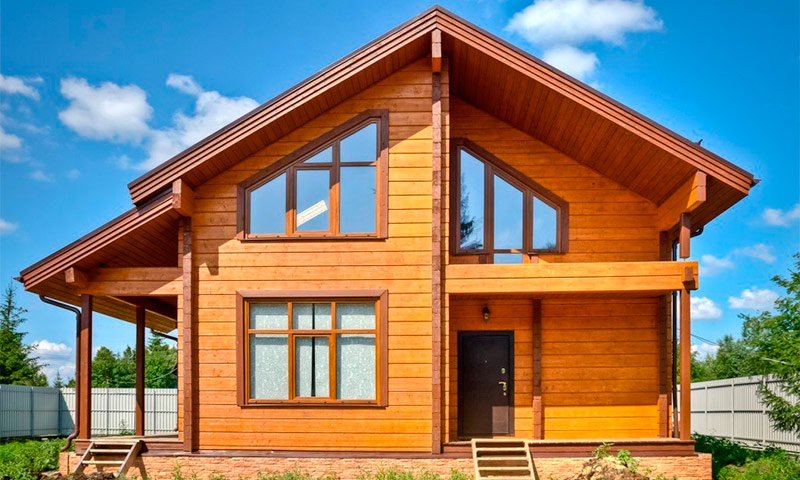
Content:
Features of the construction of timber
A house made of timber is being built in the same way as ancient huts and a tower. The difference is only in the form of the elements from which the log house is assembled, more precisely in their section. Instead of round logs, bars of a rectangular or more complex section are used.
The blockhouse is erected by successively laying the crowns on top of each other with their fastening to each other in the corners and end joints using locks that are cut down in the body of these parts. Locks are recesses of a special shape that provide mutual engagement of parts and their fixation in a horizontal plane.
Crown after wreath, they are laid one on top of the other and are connected vertically with wooden or metal pins, screw ties or compensating fastenings with a spring block. Felling differs from stone buildings in that its elements are firmly held together and form a very stable structure that can withstand even an earthquake.

The structure erected by the log house technology is undergoing shrinkage. This is mainly caused by drying of the material and a decrease in the transverse dimensions of the elements. The amount of shrinkage depends on the initial moisture content of the timber and can reach 10%. That is, a wall 3 m high as a result of shrinkage becomes 30 cm lower. As a rule, the constructed log house is left for shrinkage for up to 1-2 years, and only after that windows, doors are installed, and finishing is done.

Rafters and walls when installing a log house.

Rafters and walls in a year.
More details: https://techno.expertexpro.com/en/stroitelnye-materialy/1535-otsilindrovannoe-brevno-plyusy-i-minusy.html
The shrinkage time is highly dependent on the initial moisture of the material and the characteristics of the local climate. If the wood is well dried, the finish and woodwork can be done immediately, with some precautions and with the use of special sliding mounts.
Types of timber for a log house
For the construction of a log, a bar of three types is used:

Sawn timber.

Profiled solid bar.

Glued beam.
Each of these materials has its own characteristics.
Sawn timber
This is the easiest type of timber in production. It is made by sawing logs, in fact, by removing the croaker from it on four sides. A simple form, a simple production technology determine the low cost of the material.
The beam is made from raw or partially dried logs. Before being used at a construction site, they can be dried, but they can also be used raw, with drying as part of the log house, which avoids distortions due to rigid fastening and weight located above the elements.
Sawn timber can be subjected to additional processing - planing of the sides. Due to this, they are calibrated in width and get smooth surfaces, ready for a fine finish.

The main advantage of sawn timber is its low cost. Moreover, compared with the construction of logs, it gives walls with a flat surface.
The disadvantages of sawn timber are a consequence of the low degree of processing of the material:
- strong shrinkage of the log house;
- relatively large labor costs for caulking joints and subsequent maintenance of seals;
- the possibility of blowing seams and flowing water in them;
- tendency to warp.
Profiled beam
Profiled is called a bar having a special section, which is formed by milling. Let's evaluate the pros and cons of a profiled beam. Dried bars are usually profiled, having a natural moisture content of about 20%. But drier material can also be used.
The cross section of a profiled beam has several characteristic features. Smooth side surfaces with chamfers smoothing corners and forming a ruled structure of the log wall. The upper and lower surfaces have a relief that forms a lock, which fixes the elements of adjacent crowns and helps to seal interventional seams. Profile complexity can vary greatly between manufacturers. The profile of the edge sections does not allow water to flow into the seam.

The advantages of profiled timber:
- clear fixation of crowns when assembling the log house;
- reliable and low-cost joint sealing;
- good blow protection;
- reduced shrinkage, usually not exceeding 5%;
- smooth surface, almost no finishing required.
The disadvantages of profiled timber are the increased cost and mobility common for wood with changes in humidity, including seasonal.
Glued beam
Glued timber is obtained by gluing together 3-8 lamellas with a multidirectional structure. For this, well-dried material and modern adhesives are used, which provide high bond strength. After gluing, the desired profile is attached to the beam.

This technology provides several advantages.
- Natural restrictions on the thickness and length of parts are removed. The length can reach 20 m, which is almost impossible for a solid beam.
- Due to the combination of lamellas with a different arrangement of annual layers into one “package”, possible distortions due to changes in humidity are compensated. Glued timber is practically not subject to warping.
- The shrinkage of the log from glued beams does not exceed 1-3%, which allows to accelerate the commissioning of the building.
- Smooth walls with smooth surfaces.
There is only one significant drawback of this material in comparison with less technological analogues - the highest cost among them.
Sometimes there are doubts about the environmental friendliness of glued beams associated with the presence of adhesive joints in its structure. But subject to the gluing technology and relevant standards, the effect of glue on the composition of the air in the house is practically zero.
What is a good house made of timber
Having become acquainted with the properties of materials of various types, we will consider the general advantages and disadvantages of a timber house. First about the virtues.
Exterior and interior
The appearance of a timber house invariably makes a good impression, even if it was built without frills and has the simplest construction. Of course, this is the case when the walls are not covered by any cladding. The same can be said of the interior. When there is only wood around and there are no artificial materials, this creates a special atmosphere, which modern houses are deprived of.

Environmental friendliness
This characteristic is most often referred to as the undoubted merit of a wooden house. You can’t argue with that. Wood is the most pleasant material for humans, contact with which is natural as breathing, and completely harmless. Until the wood is infected with fungus or rot.
Simplicity and speed of construction
The log house is actually set up very quickly. The construction of a chopped house can be completed within 2-4 weeks, especially if for the foundation choose screw piles that do not require excavation and concrete work. However, if waiting for shrinkage is required, then the start of operation of the house can be delayed for a year, or even more.
Cheapness
The low cost of chopped houses due to the cheapness of wood and ease of construction. A massive foundation is not needed for a log house. It will stand perfectly on a shallow, columnar or pile foundation. This is also a factor that reduces construction costs.
But it must be borne in mind that with the increasing complexity of the project, labor costs, as well as the need for qualifications of builders, increase very much. In addition, some types of timber are not so cheap. Assessing the cost of future construction, you need to carefully consider all the nuances.
What are the disadvantages of a house from a bar
The wooden house also has drawbacks, and the main one is inseparable from the main advantage, and is associated with the properties of wood.
Biological instability
Wood is a natural material, and it decomposes under normal conditions, participating in the circulation of substances. The walls of the log house need protection from decay, damage by fungus, insects. Perhaps the most unpleasant consequence of infection with the fungus is the disappearance of one of the main advantages - environmental friendliness, since the fungus can poison the atmosphere in the house and make it unsuitable for living.
To protect the wood, wall impregnation with antiseptics is used (Environmental friendliness!). It is necessary to constantly monitor the condition of the walls, protect them from moisture.

Flammability
Combustibility of wood creates a constant fire hazard. However, any building is at risk from fire. Careful adherence to fire safety regulations will minimize this drawback. To reduce the risk, fire retardant treatment can be used (Environmental friendliness!).
Heat preservation
The ability to retain heat inside does not belong to the advantages of a chopped house, unless it is additionally insulated. But if we have a classic log house, then all heat saving is provided only by wood. The thermal conductivity of dry pine in the direction across the fibers is 0.9-0.12 W / (m ∙aboutFROM). This is about 4 to 5 times less than the thermal conductivity of a brick. Wood is deservedly called warm material.
However, with a usual thickness of 200 mm for timber walls, their reduced thermal resistance will be only about 1.6 (m² ∙aboutC) / W, and this is half as much as required by building standards, if you focus on the Moscow region. Such thermal conductivity does not even ensure compliance with sanitary standards for housing!
A bar-shaped house of a usual design without additional insulation is not suitable for permanent residence in a cold climate.
Summary
Summarize the final grades.

+ Pros of timber houses
- Special aesthetics, style of architecture and interior;
- Ideal environmental friendliness of the house, subject to the rules of its operation and careful selection of materials for interior decoration and furnishings;
- Simplicity and high speed of construction;
- Cost-effective construction.

- Cons of houses from timber
- Susceptibility of wood to rotting and damage by insects, the need for careful care, renewal of hemp;
- Susceptibility of wood to rotting and damage by insects, the need for careful care, renewal of hemp;
- Potential fire hazard, the need for particularly careful compliance with fire safety standards;
- Low energy efficiency, cold walls, intense heat loss.
Which beam to choose for construction
The total cost of building a wooden house also depends on the cost of finishing work. In the case of a wooden beam, you can choose two construction options:
- Reduce the cost of walling through the use of inexpensive non-profiled timber and incur significant costs for finishing work.
- Apply high-quality, more expensive types of timber, thereby reducing the cost of finishing.
When to prefer a timber house
- If you need a holiday home, to create an atmosphere of proximity to nature.
- For seasonal or periodic use - cottage, outbuilding, bathhouse.
- If you need to observe the style of wooden architecture, fit the house into a characteristic landscape or create such a design on your site.

